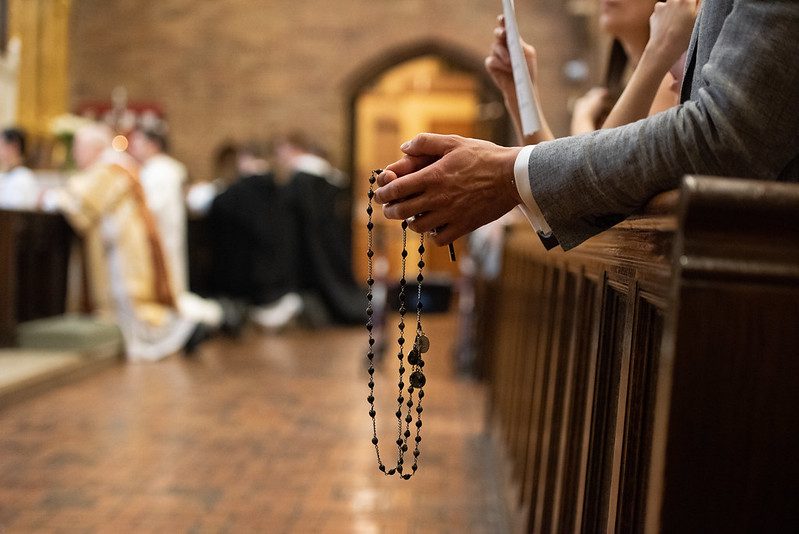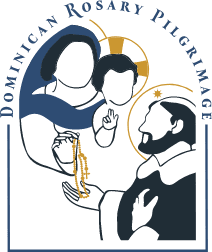The Rosary and Scripture
Dominican Friars | August 23, 2023

Even among the kaleidoscopic crowd on the subway and in the streets of New York City our Dominican habits tend to stand out and invite questions. One piece of the habit that draws a lot of attention is the Rosary. Those who are unfamiliar with the devotion usually ask what the beads are for and, often, if they are Protestant, this leads to questions about Catholic Marian devotion.
Their questions usually center around the scriptural basis for the Rosary and other Marian devotions. These types of questions are fairly easy to respond to.
The history of the Rosary is grounded firmly in the liturgical practice of reciting the Psalms. The Rosary emerged as a way for illiterate men and women (or, at least, those who could not read Latin) to participate in the Liturgy of the Hours. A full Rosary contains 150 recitations of the Hail Mary, in the Bible there are 150 Psalms. This is no mere coincidence, it is a purposeful adaptation of the Psalmody to fit the abilities and needs of Christians who would otherwise be disconnected from the Scriptures.
In addition to this overarching connection to the Psalms, each individual component of the Rosary has a scriptural connection.
The Lord’s Prayer, which begins every decade, is pulled directly from the Gospel of Matthew (Matt 6:9-13).
The Hail Mary also has a strong basis in Scripture. Its first half is a combination of two scriptural verses from the Gospel of Luke. Hail, Mary, full of grace. The Lord is with you! the angel Gabriel greets Mary in the first chapter of St. Luke’s Gospel (Luke 1:28). Blessed are you among women, and blessed is the fruit of your womb, proclaims Elizabeth in Luke’s account of the Visitation (Luke 1:42).
The second half of the Hail Mary (appended in the 15th century) is not as directly scriptural, but draws from scriptural themes and verses. Holy Mary, mother of God relates to Elizabeth’s greeting of Mary as “the mother of my Lord” (Luke 1:43). Mary is the mother of Jesus, the incarnate second person of the Trinity. She has, thus, been honored by the Church as the Theotokos (God-bearer) since the 3rd century. The title of Mother of God was confirmed by the Council of Ephesus in 431 AD. The final petition of the Hail Mary, pray for us sinners, now and at the hour of our death, draws on the Letter of James which admonishes Christians to pray for each other and proclaims that the prayers of a righteous man (or woman) has great power in its effects. (Jas 5:16). Who could be more righteous among men and women than the one seen fit by the Father to become Mother of God?
Finally, the mysteries of the Rosary follow the life of Christ as depicted by the Gospels. As we meditate on these mysteries, we are reminded of the Evangelists’ accounts of the birth, ministry, Passion and Resurrection of Jesus Christ. A popular practice is to read short passages connected with the mystery before each decade or, even, each Hail Mary. When we meditate on the mysteries, we dwell deeply on the Gospels and are led to a deeper understanding of the Scriptures by our recitation of the Rosary.
The Rosary and Tradition
After offering these arguments for the Rosary’s connection to the Scriptures, my interlocutor will usually offer his own arguments for why I am wrong and why I am really worshiping Mary instead of God. From these kinds of discussions I’ve come to see that difficulties with the Rosary are not really centered on the question of Marian devotion, but the larger problem of Sola scriptura or faith based on the Bible, alone.
The Rosary acts as a focal point for these interactions because it represents the Church’s understanding of theology, which makes use of both Scripture and Tradition (CCC 82). When we pray the Rosary we act upon, among other things, our belief in Mary’s intercessory power, the Church’s power to grant indulgences, and the various Marian apparitions that call for increased devotion to the Rosary. None of these beliefs contradict Scripture, but they are not explicitly referred to either. These beliefs rest firmly on the Gospels, but build upon that scriptural foundation to a fuller understanding of the Christian faith. Difficulties with the Rosary are often a manifestation of a reticence to connect scriptural evidence with the Tradition that undergirds the Rosary.
This does not mean that we should disregard or do away with the importance of Sacred Scripture. On the contrary, Scripture remains an important component of the faith and provides a window into the life and teachings of Our Lord Jesus Christ. But it is not the only window. The Scriptures, themselves, proclaim this in multiple passages. St. John concludes his Gospel with a proclamation that “there are also many other things that Jesus did, but if these were to be described individually, I do not think the whole world would contain the books that would be written” (John 21:25). St. Paul likewise testifies that not all of the apostles’ teaching was committed to writing, but that their oral teaching should be observed as closely as written instruction (2 Thes 2:15).
The Catholic Church combines the importance of Scripture with the magisterial Tradition guaranteed by apostolic succession. Christ commissioned Peter and the apostles to feed his lambs and tend his sheep, establishing the Church as an institution to draw men and women to a relationship with God. We receive the fullness of this nourishment when we observe the teachings and practices of Christ and the apostles as presented by both Sacred Scripture and the traditions of the Church.
One tradition that draws us close to Christ is devotion to his mother. Devotion to the Blessed Mother always begins and ends with Christ. Every dogmatic definition related to Mary has been a defense against Christological errors. The Rosary, though intensely Marian, is Christological to its core. Through the Rosary, Mary, the best of mothers, leads us to Jesus. When we pray the Rosary for Mary’s intercession, we ask her to obtain for us grace from her son, Jesus Christ. Jesus, the most perfect of sons, always listens with love to his beloved mother.
